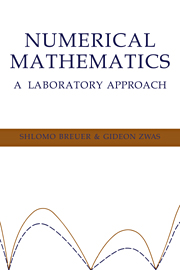Book contents
- Frontmatter
- Contents
- Preface
- Chapter 1 Mathematics in a numerical laboratory
- Chapter 2 Iterations for root extraction
- Chapter 3 Area approximations
- Chapter 4 Linear systems – An algorithmic approach
- Chapter 5 Algorithmic computations of π and e
- Chapter 6 Convergence acceleration
- Chapter 7 Interpolative approximation
- Chapter 8 Computer library functions
- Solutions to selected exercise
- Index
Chapter 8 - Computer library functions
Published online by Cambridge University Press: 05 June 2012
- Frontmatter
- Contents
- Preface
- Chapter 1 Mathematics in a numerical laboratory
- Chapter 2 Iterations for root extraction
- Chapter 3 Area approximations
- Chapter 4 Linear systems – An algorithmic approach
- Chapter 5 Algorithmic computations of π and e
- Chapter 6 Convergence acceleration
- Chapter 7 Interpolative approximation
- Chapter 8 Computer library functions
- Solutions to selected exercise
- Index
Summary
Built-in functions
The term computer library functions refers to the collection of built-in functions – sin x, In x, ex, arctan x, to name but a few – that were installed in the computer's permanent memory. These built-in functions, of course, are efficient approximations of the abstract mathematical entities they represent. By efficiency we mean that every evaluation is performed with utmost speed and yields all the correct significant figures that are available on the computing device used. The construction of such built-in functions usually entails lengthy, computationally expensive preparations, which, however, are carried out only once. The first preparatory step is to reduce, as much as possible, the interval [a, b] in which the given f(x) is to be approximated (examples of this strategy can be found in Sections 2.2 and 7.6). To guarantee the desired correct significant figures, we also must control the relative error in the approximation of f(x) in [a, b]. This issue will be discussed in Section 8.3.
We shall concentrate on polynomial approximations, making use of the results obtained in Chapter 7, and shall consider the possibility of constructing rational approximations in Sections 8.5 and 8.6. We start with polynomial approximation of trigonometric functions in the same spirit with which we treated In x in Chapter 7.
- Type
- Chapter
- Information
- Numerical MathematicsA Laboratory Approach, pp. 174 - 193Publisher: Cambridge University PressPrint publication year: 1993



